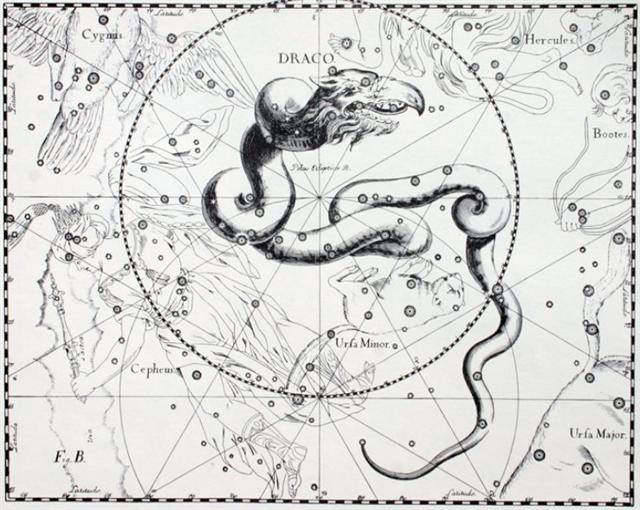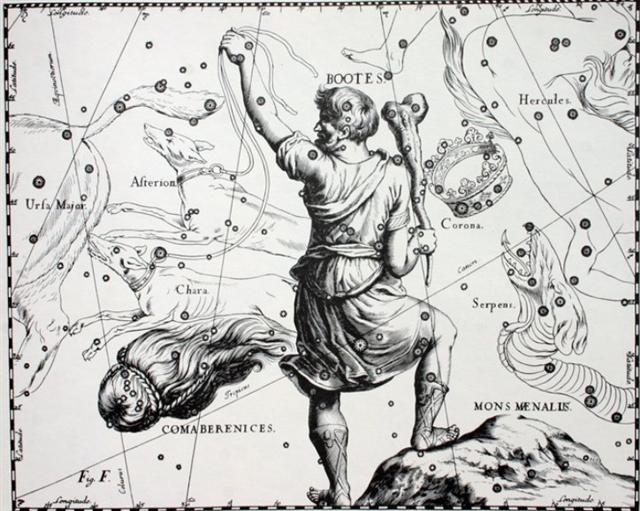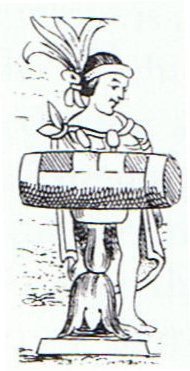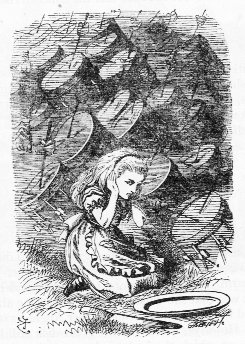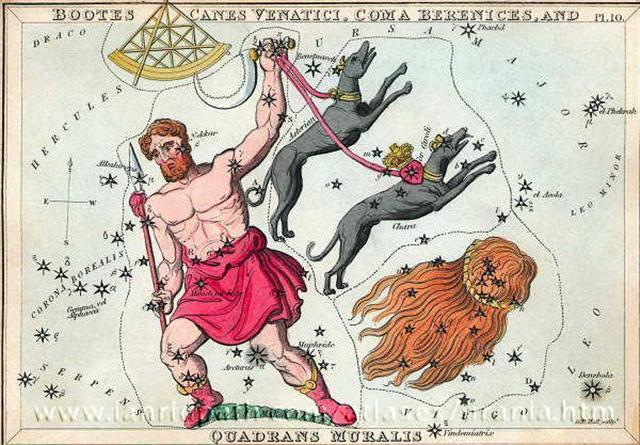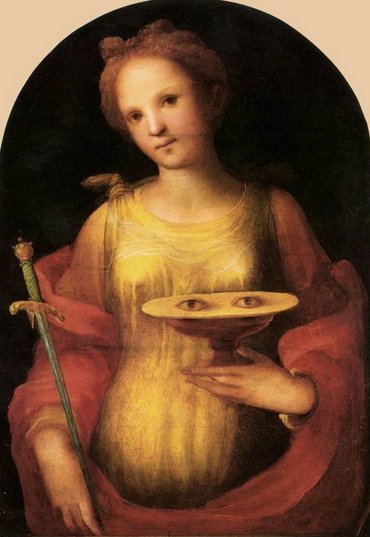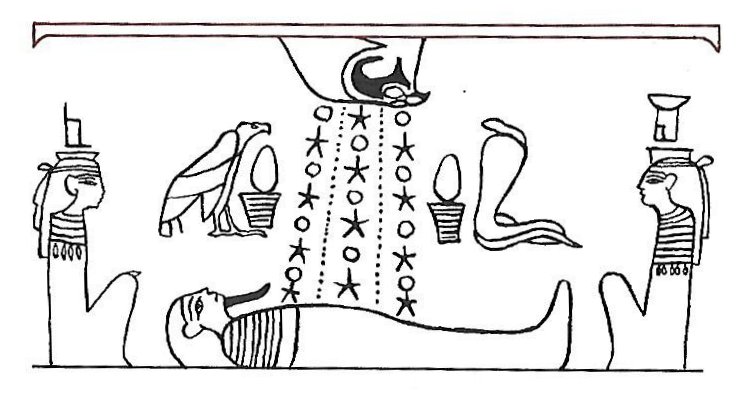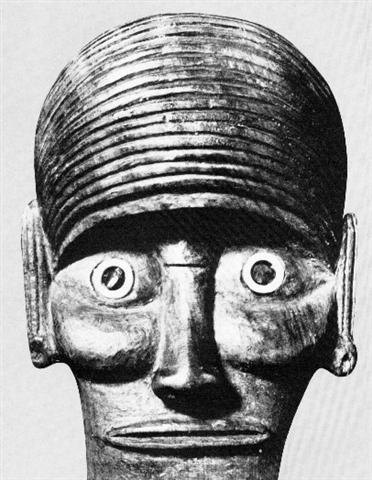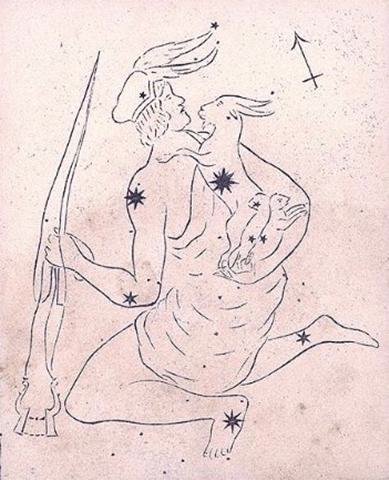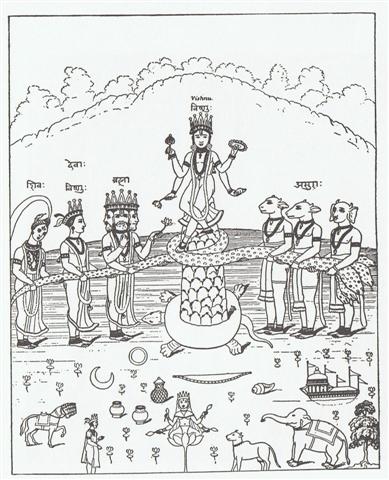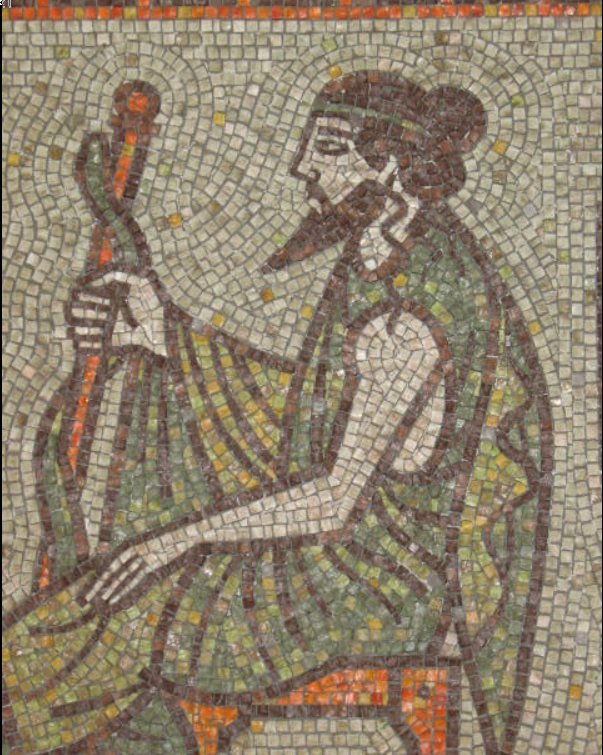Once again. In order to keep all these ideas (pictures) in order we should put them in parallel with the C text, assembling piece by piece.
... The most important of all drums, he said, was the armpit drum. The Nummo made it. It consists of two hemispherical wooden cups connected through their centres by a slender cylinder. It is like an hour-glass with a very long narrow neck. With this instrument tucked between his left arm and armpit, the drummer, by pressing on the hollow structure of thin wood, can tighten or relax the tension on the skins and so modify the tone. 'The Nummo made it. He made a picture of it with his fingers, as children do today in games with string.' Holding his hands apart, he passed a thread ten times round each of the four fingers, but not the thumb. He thus had forty loops on each hand, making eighty threads in all, which, he pointed out, was also the number of teeth of his jaws. The palms of his hands represented the skins of the drum, and thus to play on the drum was, symbolically, to play on the hands of the Nummo. But what do they represent? Cupping his two hands behind his ears, Ogotemmêli explained that the spirit had no external ears but only auditory holes. 'His hands serve for ears,' he said; 'to enable him to hear he always holds them on each side of his head. To tap the drum is to tap the Nummo's palms, to tap, that is, his ears.' Holding before him the web of threads which represented a weft, the Spirit with his tongue interlaced them with a kind of endless chain made of a thin strip of copper. He coiled this in a spiral of eighty turns, and throughout the process he spoke as he had done when teaching the art of weaving. But what he said was new. It was the third Word, which he was revealing to men ... 40 (loops on one hand) + 40 (loops on the other hand) = 80. Ears are located between the face and the hairy back side of the head. 40 - 11 (days from December 21 to January 1) = 29 (equal to the number of days in the pre-Julian month of Ianuarius). 365 + 29 = 394 (Cb1-2, ki roto). 39 * 4 = 12 * 13. At the beginning of line Cb2 there is a Sign in form of a right leg (at left, in the past) missing. The Mayan way of writing was from right to left and I have therefore twisted the original of the picture below around with 180° to show that this female drummer indeed has her left leg intact:
... The tun glyph was identified as a wooden drum by Brinton (1895, p. 92), and Marshal H. Saville immediately accepted it. Figure 49 [excerpt above] shows the Aztec drum representation relied on by Brinton to demonstrate his point. It was not then known that an ancestral Mayan word for drum was *tun: Yucatec tunkul 'divine drum' (?); Quiche tun 'hollow log drum'; Chorti tun 'hollow log drum' ... Otherwise it was Hercules (the primordial Man) who was the drummer: ... He carries an oak-club, because the oak provides his beasts and his people with mast and because it attracts lightning more than any other tree. His symbols are the acorn; the rock-dove, which nests in oaks as well as in clefts of rocks; the mistletoe, or Loranthus; and the serpent. All these are sexual emblems. The dove was sacred to the Love-goddess of Greece and Syria; the serpent was the most ancient of phallic totem-beasts; the cupped acorn stood for the glans penis in both Greek and Latin; the mistletoe was an all-heal and its names viscus (Latin) and ixias (Greek) are connected with vis and ischus (strength) - probably because of the spermal viscosity of its berries, sperm being the vehicle of life. This Hercules is male leader of all orgiastic rites and has twelve archer companions, including his spear-armed twin, who is his tanist or deputy. He performs an annual green-wood marriage with a queen of the woods, a sort of Maid Marian. He is a mighty hunter and makes rain, when it is needed, by rattling an oak-club thunderously in a hollow oak and stirring a pool with an oak branch - alternatively, by rattling pebbles inside a sacred colocinth-gourd or, later, by rolling black meteoric stones inside a wooden chest - and so attracting thunderstorms by sympathetic magic ... Drumming was anciently the means by which to communicate with the gods above, and anciently the drum was the shaman's instrument. ... It was 4 August 1968, and it was the feast day of Saint Dominic, patron of Santo Domingo Pueblo, southwest of Santa Fe. At one end of the hot, dusty plaza, a Dominican priest watched nervously as several hundred dancers arranged in two long rows pounded the earth with their moccasined feet as a mighty, collective prayer for rain, accompanied by the powerful baritone singing of a chorus and the beat of drums. As my family and I viewed this, the largest and in some ways the most impressive Native American public ceremony, a tiny cloud over the Jémez Mountains to the northwest got larger and larger, eventually filling up the sky; at last the storm broke, and the sky was crisscrossed by lightning and the pueblo resounded with peals of rolling thunder ...
At the end of the years drums were useful. At that time of the year nothing was left (kore) - as on the plate in front of Alice. The Sun had reached the (empty) Pauper's Bowl (Nusakan):
This in a way seems to be the opposite of what can read at the beginning of line Ba8:
The Heart of the Serpent (Cor Serpentis) was at the Sun *237 (= 8 * 29½ + 1) right ascension days after 0h. The Head of the Serpent-carrier (Ras Alhague) came *29 days later. DAY 237 + 29 = DAY 266.
The Rain (te ua) was at heliacal Cor Serpentis when the Full Moon was about to reach the Pleiades:
... We can perceive the gap in Cb2-6 as an illustration of the gap here forced between the upside down sky bowl (right) and the world below - receiving the benefits of good life (goods) from above. South of the equator November was a spring month corresponding to May in the north ...
The beginning of the Pleiades year could evidently have been illustrated with Rain at the back side followed by a person (the Robber, the Smith) equipped with an 'elbow' (digging stick) in front enabling him to work the ground after he had 'landed'.
The design of the ua type of glyph makes sense if we perceive the wrinkled 'eyebrows of winter' turned a quarter to the right.
Although we have also to twist the head of this ua dance paddle figure around a quarter.of a circle from the view en face in order to see the part in the middle. I imagine the Serpent could once upon a time have been the King Cobra, the top predator who devoured all the other snakes (like a mighty river who swallowed all its tributaries), a serpent who could raise his head (Ras Alhague) as high as a man. ... The 'classic' version, however, was much more detailed: the rope would seem to rise high into the skies, disappearing from view. The boy would climb the rope and be lost to view. The magician would call back his boy assistant, and, on getting no response, become furious. The magician then armed himself with a knife or sword and climbed the rope, vanishing too. An argument would be heard, and then limbs would start falling, presumably cut from the assistant by the magician. When all the parts of the body, including the torso, landed on the ground, the magician would climb down the rope. He would collect the limbs and put them in a basket, or collect the limbs in one place and cover them with a cape or blanket. Soon the boy would appear, restored ... Once upon a time - in nomadic life, before the great agricultural revolution - the Restoring of Goods (the births of the animals such as goat kids - and later lambs) had been defined by Castor.
... In Hindu legend there was a mother goddess called Aditi, who had seven offspring. She is called 'Mother of the Gods'. Aditi, whose name means 'free, unbounded, infinity' was assigned in the ancient lists of constellations as the regent of the asterism Punarvasu. Punarvasu is dual in form and means 'The Doublegood Pair'. The singular form of this noun is used to refer to the star Pollux. It is not difficult to surmise that the other member of the Doublegood Pair was Castor. Then the constellation Punarvasu is quite equivalent to our Gemini, the Twins. In far antiquity (5800 B.C.) the spring equinoctial point was predicted by the heliacal rising of the Twins ... ... the Aztecs took Castor and Pollux (alpha beta Geminorum) for the first fire sticks, from which mankind learned how to drill fire. This is known from Sahagún: Florentine Codex (trans. Anderson and Dibble), vol. 7, p. 60. See also R. Simeon, Dictionnaire del la Langue Nahuatl (1885) s.v. 'mamalhuaztli: Les Gemeaux, constellation', who does not mention though, that Sahagún identified mamalhuaztli with 'astijellos', fire sticks. Also, the Tasmanians felt indebted to Castor and Pollux for the first fire (see J. G. Frazer, Myths of the Origin of Fire [1930], pp. 3f.). Considering that the equinoctial colure of the Golden Age ran through Gemini (and Sagittarius), the fire sticks in Gemini offer a correct rhyme to a verse in a Mongolian nuptial prayer which says: 'Fire was born, when Heaven and Earth separated', in other words, before the falling apart of ecliptic and equator there was no 'fire', the first being kindled in the Golden Age of the Twins ...
But this was now in the past, as expressed by the Charioteer carrying the goats on his back side:
For the Serpent had become the relevant (and pregnant) symbol. Number 29 (= 266 - 237) referred to the dark night of the Moon. ... When calm was restored, the smith was still on the roof, standing erect facing towards the north, his tools still in the same position. But in the shock of landing the hammer and the anvil had broken his arms and legs at the level of elbows and knees, which he did not have before. He thus acquired the joints proper to the new human form, which was to spread over the earth and to devote itself to toil ...
The flow of sweet rain water through rivers and ditches restored life in the agricultural cosmos, as when the fruitful Dark Moon was followed by an increase in light. ...when the new moon appeared women assembled and bewailed those who had died since the last one, uttering the following lament: 'Alas! O moon! Thou has returned to life, but our departed beloved ones have not. Thou has bathed in the waiora a Tane, and had thy life renewed, but there is no fount to restore life to our departed ones. Alas'... The hidden one (Mercury, Hermes, Hiro) was a healer who restored life (rakau). Hiro. 1. A deity invoked when praying for rain (meaning uncertain). 2. To twine tree fibres (hauhau, mahute) into strings or ropes. Ohirohiro, waterspout (more exactly pú ohirohiro), a column of water which rises spinning on itself. Vanaga. To spin, to twist. P Mgv.: hiro, iro, to make a cord or line in the native manner by twisting on the thigh. Mq.: fió, hió, to spin, to twist, to twine. Ta.: hiro, to twist. This differs essentially from the in-and-out movement involved in hiri 2, for here the movement is that of rolling on the axis of length, the result is that of spinning. Starting with the coir fiber, the first operation is to roll (hiro) by the palm of the hand upon the thigh, which lies coveniently exposed in the crosslegged sedentary posture, two or three threads into a cord; next to plait (hiri) three or other odd number of such cords into sennit. Hirohiro, to mix, to blend, to dissolve, to infuse, to inject, to season, to streak with several colors; hirohiro ei paatai, to salt. Hirohiroa, to mingle; hirohiroa ei vai, diluted with water. Churchill. Ta.: Hiro, to exaggerate. Ha.: hilohilo, to lengthen a speech by mentioning little circumstances, to make nice oratorial language. Churchill. Whiro 'Steals-off-and-hides'; also [in addition to the name of Mercury] the universal name for the 'dark of the Moon' or the first day of the lunar month; also the deity of sneak thieves and rascals. Makemson. Rakau. Raau, medicine, remedy, drug. Ra'a'u, scratch on the skin. Rakau, a plant. Râkau, goods, property. Vanaga. 1. Wood; rakau ta, cudgel, stick. P Pau.: rakau, tree, to dress a wound. Mgv.: rakau, wood, timber, a tree; medicine, a remedy; an object. Mq.: ákau, wood, tree. Ta.: raáu, id. 2. Medicine, remedy, potion, ointment, furniture, any precious object, resources, baggage, riches, heritage, dowry, merchandise, treasure, wealth; rakau hakaneinei, purgative; rakau nui, rich, opulent; rakau kore, poor, beggar, indigent, miserable, an inferior; hakakamikami ki te rakau, to impoverish; rakau o te miro, ballast. Mq.: akau, anything in general. The medicine sense is particularized in Tonga, Nukuoro, Hawaii, Tahiti, Mangareva, Paumotu. In no other speech does wood stand so fully for wealth of possessions, but it will be recalled that Rapanui is destitute of timber and depends wholly upon driftwood. Churchill. A fundametal law of physics says that everything 'runs down', the enthropy is always increasing. A vase (or water-pitcher) which falls from the table down onto the floor going into zillions of pieces can never be restored again by the same forces which destroyed it. Ancient man knew the answer to this puzzle. In a whirlpool all small pieces of flotsam will as if by magic assemble in its center, then they will go down under the surface. In the dark waters below there is an unseen mysterious process which will restore the broken pieces into a new entity which later will be 'reborn'. The process is not possible to describe by physics, it is a process of life. Down it goes, everything, sooner or later. But it will come back, fresh as morning dew. The metabolism disintegrates but the pieces are reused like old bricks when a new wall is built. This process of Mother Nature was harnessed by man entering the agricultural age.
|
|||||||||||||||||||||||||||||||||||||||||||||||||||||||||||||||||||||||||||||||||||||||||||||||||||||||||||||||||||||||||||||||||||||||||||||||||||||||||||||||||||||||||||||||||||||||||||||||||||||||||||||||||||||||||||||




